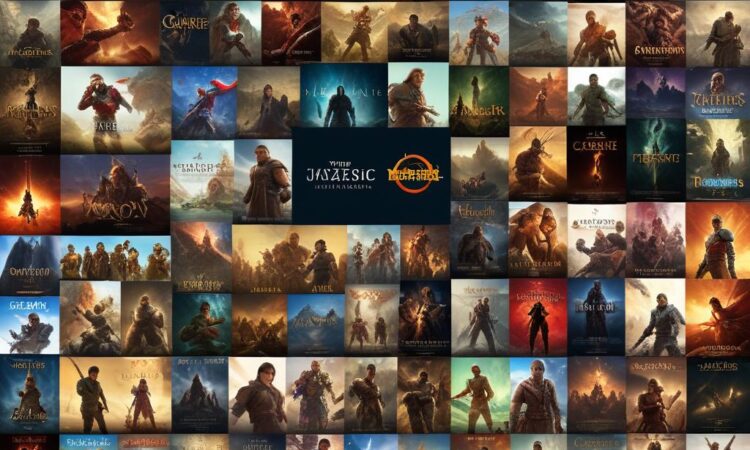Film Adaptations of Popular Books and Video Games
The cinematic landscape is increasingly populated by adaptations of beloved literary works and immersive video game experiences. This trend, fueled by the desire to capitalize on established fandoms and proven source material, has sparked both excitement and trepidation among audiences. This exploration delves into the challenges and opportunities inherent in translating these vibrant worlds from the page and screen to the silver screen, examining the success and reception of recent adaptations.
The Allure of Adaptation
The appeal of adapting popular books and video games into films is undeniable. Established narratives, captivating characters, and devoted fan bases provide a built-in audience and potential for box office success. Books, with their rich backstories and intricate world-building, offer a foundation for expansive cinematic narratives, while video games, with their immersive gameplay and dynamic action sequences, hold the potential for visually stunning and thrilling spectacles. Moreover, adaptations can introduce these worlds to a wider audience, attracting new viewers and expanding the reach of the original works.
The Challenges of Translation
However, the transition from page and screen to the big screen is rarely seamless. The inherent differences between mediums pose significant challenges:
1. Condensing Narrative
One of the most significant challenges lies in condensing vast narratives into a manageable film runtime. Books, with their leisurely pace and intricate details, often require substantial streamlining for the film format. This can involve omitting subplots, characters, or entire sequences, potentially altering the narrative flow and character development.
2. Adapting Visuals
Visualizing the worlds and characters envisioned in books and video games is another hurdle. Readers and gamers have their own interpretations, which may differ drastically from the director’s vision. Creating sets, costumes, and special effects that resonate with the source material, while also appealing to a wider audience, requires meticulous planning and creative execution.
3. Balancing Fidelity and Innovation
Striking a balance between fidelity to the source material and creative innovation is crucial. Adhering too closely to the original can result in a derivative and uninspired adaptation, while straying too far can alienate loyal fans. The art of adaptation lies in finding a delicate balance, respecting the source while introducing new perspectives and interpretations.
4. Catering to Different Audiences
Films based on books and video games need to appeal to both existing fans and new audiences. This requires careful consideration of tone, pacing, and characterization. While satisfying core fans is essential, adaptations need to be accessible and engaging for viewers unfamiliar with the source material.
Recent Adaptations: Successes and Setbacks
The recent landscape of adaptations offers a spectrum of examples, showcasing both triumphs and pitfalls. Some films have faithfully captured the essence of their source material, winning critical acclaim and commercial success. Others have faltered, struggling to translate the nuances of the original works or failing to connect with audiences.
Successful Adaptations
Adaptations like \”The Lord of the Rings\” trilogy, \”Harry Potter\” series, and \”The Hunger Games\” franchise have demonstrated the potential for successful adaptations. These films retained the core themes, characters, and worlds of their source material while delivering compelling cinematic experiences. They achieved critical acclaim and box office success, expanding the reach of the original works and captivating new audiences.
Setbacks and Criticisms
However, not every adaptation achieves the same level of success. Films like \”The Last Airbender,\” \”Eragon,\” and \”The Mortal Instruments: City of Bones\” received critical backlash for their deviation from the source material, their reliance on CGI over storytelling, and their lack of emotional resonance. These adaptations failed to capture the spirit of the original works, leading to disappointed fans and lukewarm reception.
The Future of Adaptation
The future of adapting books and video games into films remains uncertain. While the potential for success exists, the challenges remain significant. The success of future adaptations will likely depend on several factors, including:
1. Careful Adaptation
Adaptations that prioritize fidelity to the source material, while also incorporating creative innovation, will resonate with both existing fans and new audiences.
2. Strong Storytelling
Focus on strong storytelling, captivating characters, and compelling narratives will be crucial. Films need to stand on their own merit, offering a compelling cinematic experience beyond the source material.
3. Skillful Direction
Directors with a deep understanding of the source material and a vision for translating it to the screen will be vital. Their ability to capture the essence of the original work, while also bringing their own unique perspective, will contribute to the success of the adaptation.
4. Engaged Audiences
Ultimately, the success of film adaptations relies on the engagement of the audience. Adaptations that cater to both existing fans and new viewers, offering a compelling and entertaining cinematic experience, will thrive. Films that fail to connect with their audience, either by deviating too far from the source material or by neglecting strong storytelling, will likely fall short.
Conclusion
The trend of adapting popular books and video games into feature films is a dynamic one, filled with opportunities and challenges. Successful adaptations require a delicate balance of fidelity, innovation, and strong storytelling. By carefully adapting the source material, focusing on captivating narratives, and engaging with diverse audiences, filmmakers can create compelling cinematic experiences that honor the original works while attracting new viewers to the vibrant worlds of literature and gaming.

